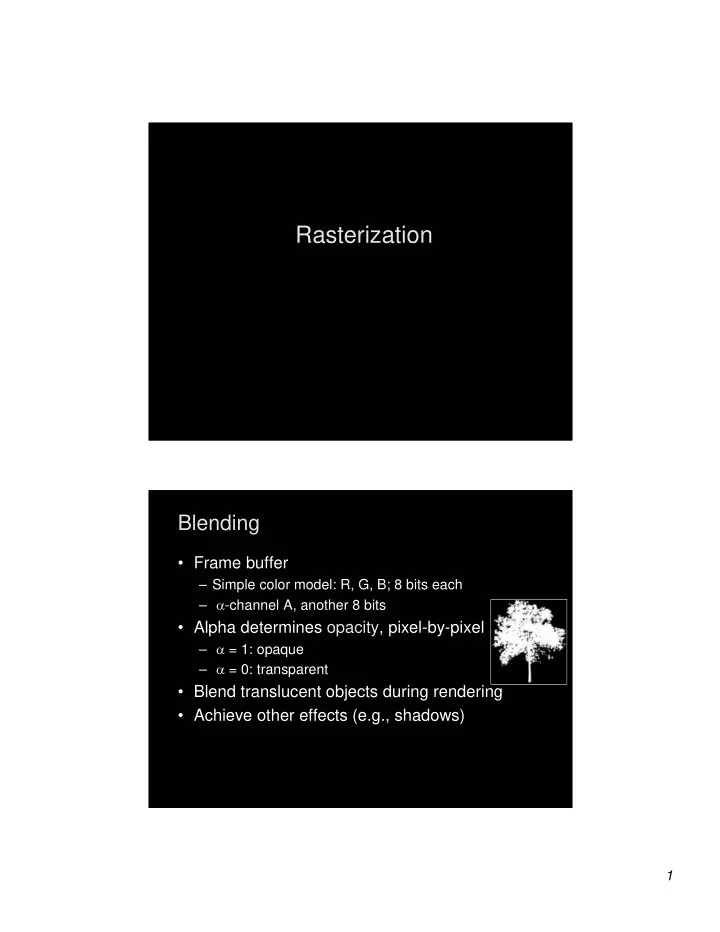

Rasterization Rasterization Blending Blending • Frame buffer – Simple color model: R, G, B; 8 bits each – � -channel A, another 8 bits • Alpha determines opacity, pixel-by-pixel – � = 1: opaque – � = 0: transparent • Blend translucent objects during rendering • Achieve other effects (e.g., shadows) 1
Image Compositing Image Compositing • Compositing operation – Source: s = [s r s g s b s a ] – Destination: d = [d r d g d b d a ] – b = [b r b g b b b a ] source blending factors – c = [c r c g c b c a ] destination blending factors – d’ = [b r s r + c r d r b g s g + c g d g b b s b + c b d b b a s a + c a d a ] • Overlay n images with equal weight – Set � -value for each pixel in each image to 1/n – Source blending factor is “ � ” – Destination blending factor is “1” Blending in OpenGL Blending in OpenGL • Enable blending glEnable(GL_BLEND); • Set up source and destination factors glBlendFunc(source_factor, dest_factor); • Source and destination choices – GL_ONE, GL_ZERO – GL_SRC_ALPHA, GL_ONE_MINUS_SRC_ALPHA – GL_DST_ALPHA, GL_ONE_MINUS_DST_ALPHA 2
Blending Errors Blending Errors • Operations are not commutative • Operations are not idempotent • Interaction with hidden-surface removal – Polygon behind opaque one should be culled – Translucent in front of others should be composited – Solution: • Two passes using alpha testing (glAlphaFunc): 1 st pass alpha=1 accepted, and 2 nd pass alpha<1 accepted • make z-buffer read-only for translucent polygons (alpha<1) with glDepthMask(GL_FALSE); Antialiasing Revisited Antialiasing Revisited • Single-polygon case first • Set � -value of each pixel to covered fraction • Use destination factor of “1 – � ” • Use source factor of “ � ” • This will blend background with foreground • Overlaps can lead to blending errors 3
Antialiasing with Multiple Polygons Antialiasing with Multiple Polygons • Initially, background color C 0 , � 0 = 0 • Render first polygon; color C 1 fraction � 1 – C d = (1 – � 1 ) C 0 + � 1 C 1 – � d = � 1 • Render second polygon; assume fraction � 2 • If no overlap (a), then – C’ d = (1 – � 2 ) C d + � 2 C 2 – � ’ d = � 1 + � 2 Antialiasing with Overlap Antialiasing with Overlap • Now assume overlap (b) • Average overlap is � 1 � 2 • So � d = � 1 + � 2 – � 1 � 2 • Make front/back decision for color as usual 4
Antialiasing in OpenGL Antialiasing in OpenGL • Avoid explicit � -calculation in program • Enable both smoothing and blending glEnable(GL_POINT_SMOOTH); glEnable(GL_LINE_SMOOTH); glEnable(GL_BLEND); glBlendFunc(GL_SRC_ALPHA, GL_ONE_MINUS_SRC_ALPHA); Temporal Aliasing Temporal Aliasing • Sampling rate is frame rate (30 Hz for video) • Example: spokes of wagon wheel in movie • Possible to supersample and average • Fast-moving objects are blurred • Happens automatically in video and movies – Exposure time (shutter speed) – Memory persistence (video camera) – Effect is motion blur 5
Motion Blur Motion Blur • Achieve by stochastic sampling in time • Still-frame motion blur, but smooth animation Motion Blur Example Motion Blur Example Looks like squash and stretch!! T. Porter, Pixar, 1984 16 samples/pixel 6
Depth of Field Depth of Field Filter for Depth-of-Field Filter for Depth-of-Field • Simulate camera depth-of-field – Keep plane z = z f in focus – Keep near and far planes unchanged • Move viewer by � x • Compute x’ min , x’ max , y’ min , y’ max for new frustum 7
Depth-of-Field Jitter Depth-of-Field Jitter • Compute • Blend the two images in accumulation buffer OpenGL Depth of Field Example OpenGL Depth of Field Example Can jitter in both x- and y-directions… See depth of field example: http://www.opengl.org/developers/code/examples/redbook/redbook.html 8
Close-up Close-up Soft shadows too… Soft shadows too… Simulating Soft Shadows with Graphics Hardware (1997) Paul S. Heckbert & Michael Herf, CMU Technical Report 9
Depth Cueing and Fog Depth Cueing and Fog • Another application of blending • Use distance-dependent (z) blending – Linear dependence: depth cueing effect – Exponential dependence: fog effect – This is not a physically-based model Example: Fog Example: Fog • Fog in RGBA mode: C = fC i + (1-f)C f – f : depth-dependent fog factor GLfloat fcolor[4] = {...}; glEnable(GL_FOG); glFogf(GL_FOG_MODE, GL_EXP); glFogf(GL_FOG_DENSITY, 0.5); glFogfv(GL_FOG_COLOR, fcolor); 10
Example: Depth Cue Example: Depth Cue float fogColor[] = {0.0f, 0.0f, 0.0f, 1.0f}; gl.glEnable(GL_FOG); gl.glFogi (GL_FOG_MODE, GL_LINEAR); gl.glHint (GL_FOG_HINT, GL_NICEST); /* per pixel */ gl.glFogf (GL_FOG_START, 3.0f); gl.glFogf (GL_FOG_END, 5.0f); gl.glFogfv (GL_FOG_COLOR, fogColor); gl.glClearColor(0.0f, 0.0f, 0.0f, 1.0f); Antialiasing – again! Antialiasing – again! (Jim Blinn article) (Jim Blinn article) 11
12
Recommend
More recommend